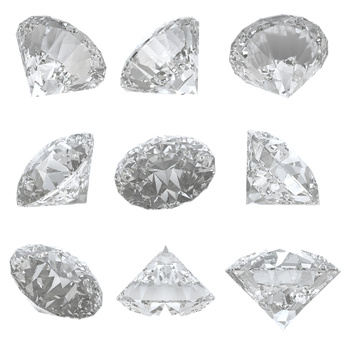What Is a Girdle?
A girdle is one of the parts of a cut diamond; more specifically, it is the widest part of the stone.

The girdle is the demarcation line between the top and bottom parts of a diamond.
The girdle is also the demarcation line between the top and bottom parts of a diamond.
The portion above the girdle is called the crown, and the part below is called the pavilion.
Why Is the Girdle So Important?
The girdle plays an important role when measuring the proportions of a diamond.
The other parts of the stone are compared with the girdle in terms of size, and this comparison is used to determine how well the stone is cut.
For example, the radius of the flat top of the diamond (the table), the height of the crown and the depth of the pavilion, and the height of the entire diamond are often expressed as a percentage of the girdle, which is a measure of the total width of the stone.
So why do all those percentages matter? Well, they are important because they determine how close the cut of the diamond is to the so-called ideal cut.
An ideal-cut diamond has optimal proportions that allow it to maximize its brilliance and sparkle when light enters it. That’s why the size of all those parts relative to the girdle can give you a hint as to how beautiful the diamond will look when worn.
Why Is Girdle Thickness Important?
One of the most important characteristics of the girdle is how thick it is.
If the girdle is too thin, it may easily break or chip. This can be especially problematic if you need to have the diamond set in a mounting as the girdle can get damaged in the process.
If the stone’s girdle is cut too thick, the additional size of this part will have come at the expense of other parts of the stone, and that’s why its proportions will most likely not be optimal.
A thick girdle can therefore indicate that the stone’s brilliance and sparkle will be diminished.
A girdle that is irregular, i.e. some portions of it are thinner while others are much thicker, is also problematic. The irregularity means that the facets immediately above and below the girdle are not well aligned and are disproportional.
Generally, whenever you see any signs of bad proportions in a diamond, be aware that it was poorly cut, detracting from the stone’s appearance.
How Is the Girdle Graded?
The G.I.A. grades the girdle using an 8-grade scale; the grades are: Extremely Thin, Very Thin, Thin, Medium, Slightly Thick, Thick, Very Thick, and Extremely Thick.
If a diamond has been graded by the G.I.A., you will be able to see the girdle grade on the diamond certificate.
If you click on any of these G.I.A.-certified diamonds, you’ll be able to see its girdle grade listed on its grading report.
What Is the Best Girdle Thickness?
The girdle should fall anywhere between Very Thin and Thick. The best thickness would be somewhere in the middle, ideally either Thin or Medium.
Avoid girdles that are Extremely Thin, Very Thick or Extremely Thick.
Remember, a disproportional girdle, whose size is in either extreme, indicates a disproportional cut. So, if you don’t know anything else about a diamond’s dimensions, just look at how thick its girdle is.
Where to Buy Diamond Jewelry?
We recommend James Allen (read review) because you can see a 360-degree video for any diamond before buying it.
Blue Nile is another reputable diamond retailer we recommend.














